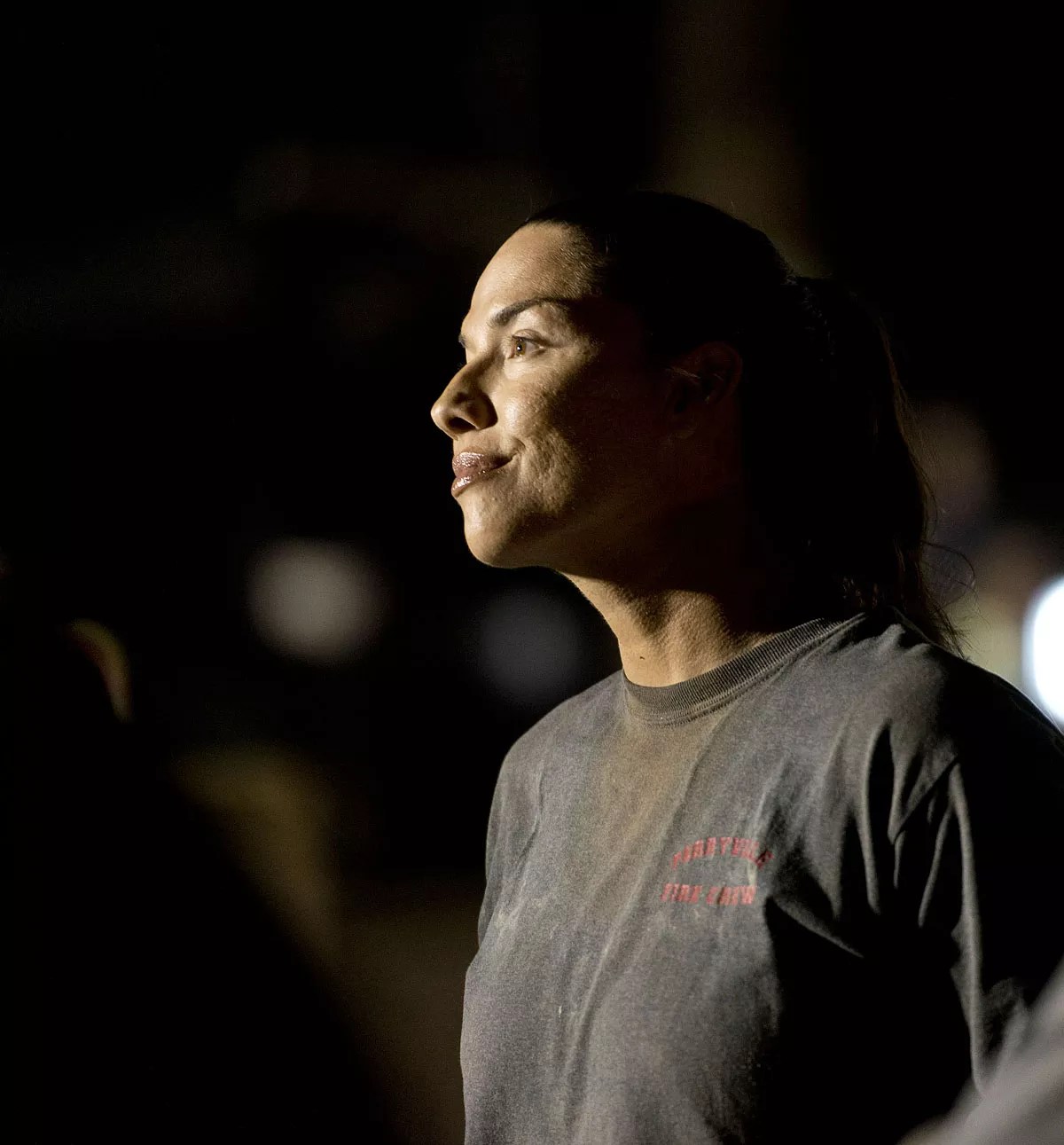
Pablo Robles

Audio By Carbonatix
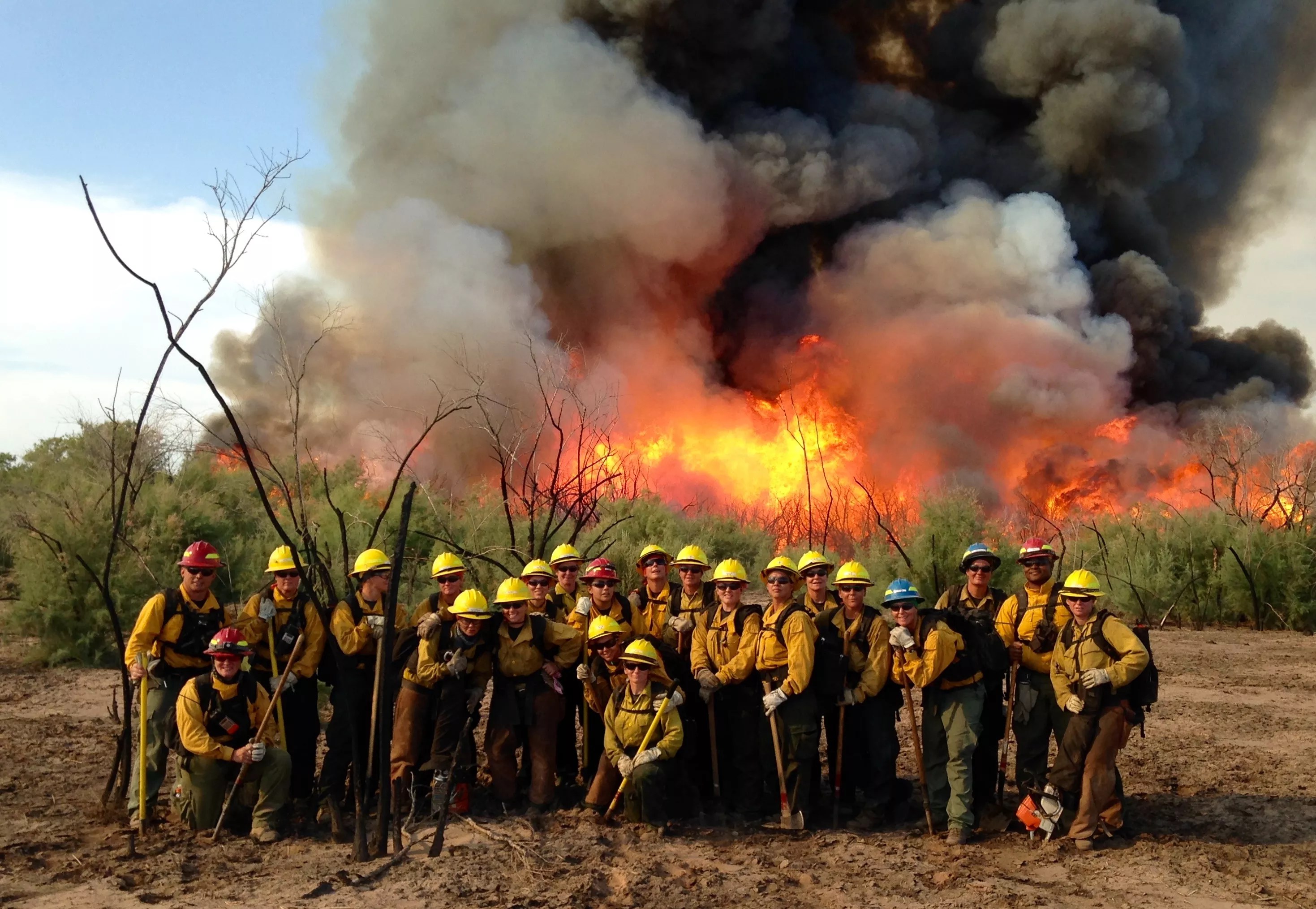
The Perryville women
Courtesy of Arizona Department of Forestry and Fire Management
Up on the Mogollon Rim, it’s hot, it’s dark, and the air is thick with the scent of charred ponderosa pine, but this is where 20 remarkable women are unshackling themselves from their corner of hell.
To reach them, you have to bounce 20 miles along dusty dirt roads through the Coconino and Apache-Sitgreaves national forests. You cross the areas where the Highline Fire scaled the cliffs and charred the forest floor.
And then, quite suddenly, tucked away amid the tall pines, you find them, where halogen floodlights cast otherworldly shadows on the stands of trees and white pavilion tents.
Phoenix, make your New Year’s Resolution Count!
We’re $12,500 away from reaching our $30,000 year-end fundraising goal. Your support could be what pushes us over the top. If our work has kept you informed, helped you understand a complex issue, or better connected you to your community, please consider making a contribution today.
This is Spike Camp 139. It’s a small city of 1,181 firefighters in the wilderness, powered by generators gurgling out their diesel fumes.
Inside one pavilion, dozens of firefighters are sitting down to something welcome: a hot meal and turkey sandwiches. They talk wearily of their favorite meals back home, or of reunion. Many know each other from past fires, going back 40 years in some cases.
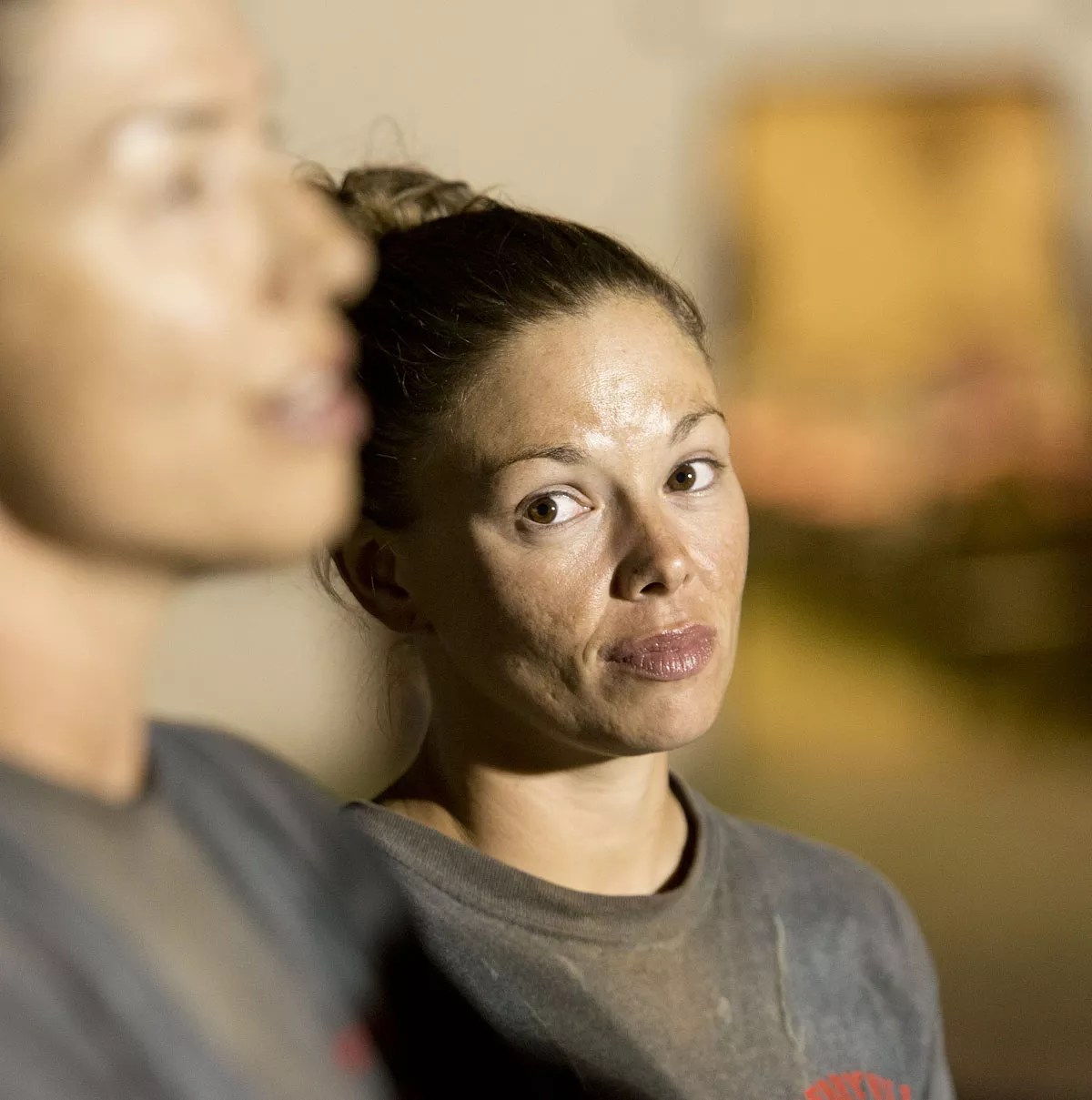
Krista Countryman
Pablo Robles
Among the firefighters in this tent, not far from the front lines of the Highline Fire, is an extraordinary crew of 20 women, the only one of its kind in Arizona.
They’ve been here for a week. After tossing in the trash the polystyrene plates from their catered meal, they head off to their first shower in six days.
“This is my redemption,” says Krista Countryman, a 33-year-old from Mesa, who is a crew leader. There is no hint of irony.
She’s serious, and she’s referring not to the shower, but to the fire.
“Fire made me who I am,” says 28-year-old Sarah Schneck of Peoria, who is also a crew boss.
Another crew leader, 41-year-old Regina Brandt of Phoenix, shares the squad’s motto: “Be phenomenal, or be forgotten.”
They know a lot about being forgotten. They are among the most forgotten people in society. All are inmates from Perryville Prison.
They are learning the phenomenal part.
A DAY ON THE FIRE LINE
The Highline Fire has been burning for nine days.
Fire is an angry brat. It rages through the day, but at night it lays down, exhausted by cooler air and calmer winds.
June 20 starts with ominous signs. The brat has been cornered, cowed, but not beaten, not yet. The brat has a tantrum still left in him.
A dozen miles south of Spike Camp 139, incident commanders bend over maps on tables. They scan reports from the National Weather Service, the Southwest Coordination Center in Albuquerque.
The fire intel is bad, worst-case almost. Humidity will drop below 5 percent. A measure of fuel combustibility in the Coconino National Forest is higher than safe. Wind gusts of 40 mph are expected up on the Rim. An index for unstable air is at its highest, most dangerous level. By lunch, the thermometer reaches 103 degrees in Payson.
Back in Phoenix, people brace for 119-degree heat. Some flights at Sky Harbor are canceled.
On such a day almost exactly 27 years ago, Arizona faced what was then, before most people had ever heard of Yarnell, the deadliest wildfire in state history.
The Dude Fire began when a lightning bolt scorched the scrub in the rolling hills at the foot of the cliffs that form the Mogollon Rim. That day, Phoenix recorded its highest all-time temperature: 122 degrees.
Flames trapped a crew from Perryville Prison. Six died, including the first woman firefighter in Arizona to perish.
It was June 26, 1990.
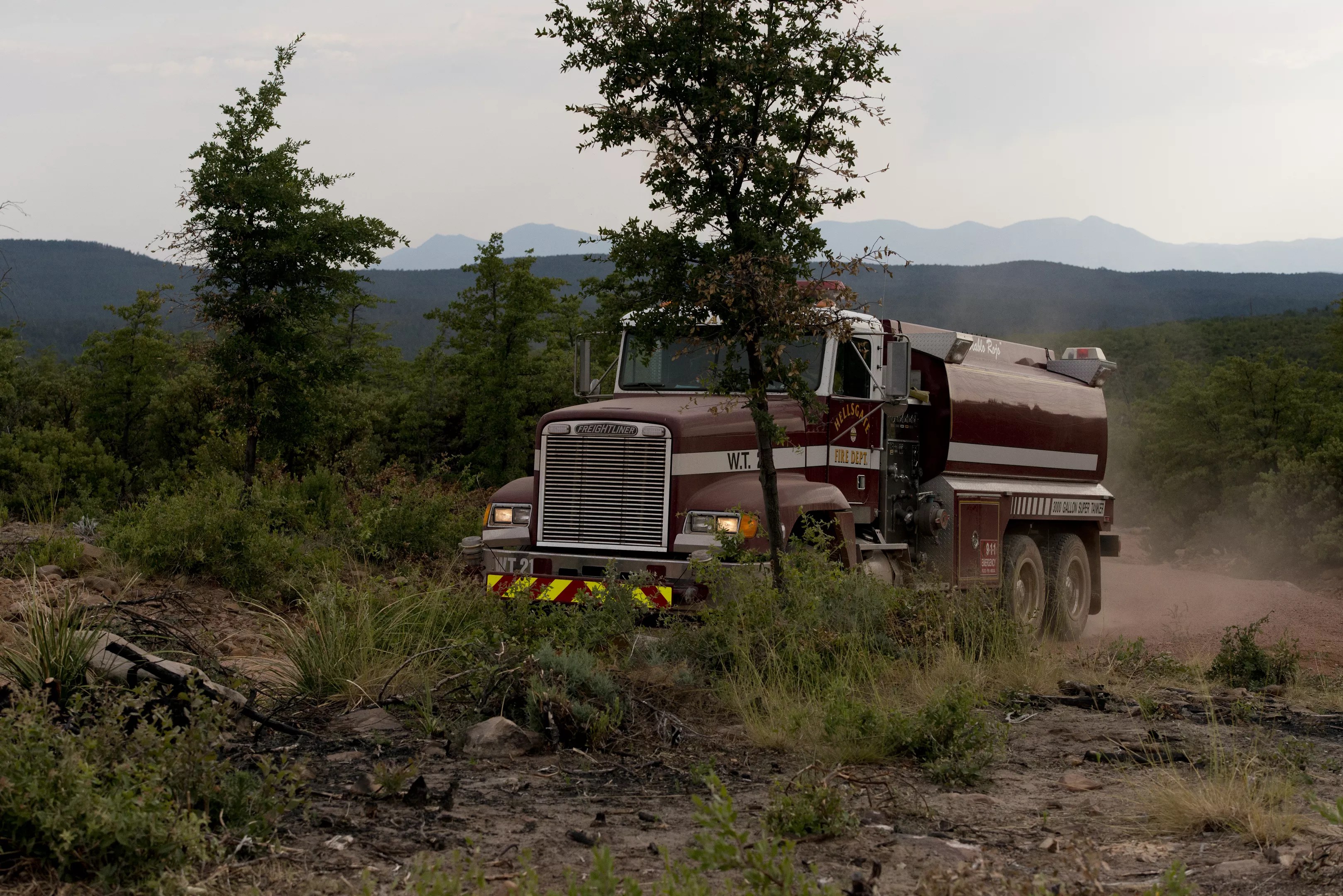
Fire crews patrol the hills above Ellison Creek Estates looking out for hotspots on the Highline Fire near Prescott.
Pablo Robles
Now, the anniversary is only days away, and every firefighter at the Highline Fire knows it. Their fire had started less than a mile from the origin of the Dude Fire. Like the Dude Fire, it raced up the slopes and canyons and cliffs and scaled the Rim. Then, it burned toward Flagstaff.
And like the Dude Fire, a Perryville Prison crew works the lines.
Sentimentality didn’t put them there. Phenomenal did.
When John Truett, the Arizona State fire management officer, saw the Perryville team in action on a fire earlier this summer, he handpicked it for the Highline Fire. He knew Rim Country was one of the toughest environments in the U.S. to battle fire. The terrain is tricky, and the cliffs and monsoon storms create erratic winds and sudden gusts.
“They really impressed our ops people and our safety people. People noticed their work ethic. That’s a high regard for that crew,” Truett says.
The Perryville women’s crew began in 2005. It’s the only all-woman firefighting crew from an Arizona prison, but Truett says he’d like to see more such crews, such is their caliber and commitment.
“They just look out for one another. They are always accomplishing every task the team gets. You can just tell they do it as a team. It’s a trait that makes a good crew, and not all crews have it,” he says.
Truett is the second in command at the Highline Fire. His boss has also noticed the Perryville crew’s assets.
“They are the most dedicated, disciplined people you’ll find on the fire. They are motivated to be out here,” says Bea Day, the Type I incident commander on the Highline Fire.
Up at Spike Camp 139, Terry Hudson, the state fuels manager and the man who oversees the prison crews, says this year’s Perryville team is one of the hardest-working of any fire crew he’s ever worked with. He’s been doing it 17 years.
The personal journey to that place for these women on the crew has been bumpier, longer, and more serpentine than the Fire Road 300 that carried them up to their worksite. They had to free themselves of the prisons inside their own minds first.
FIRE IS THEIR SALVATION
Sarah Schneck landed in Perryville in 2014.
She didn’t think she was good at anything. So she took drugs. Then drugs took her.
On the yard inside Perryville one day, she was watching her friend working out. She was part of a fire crew.
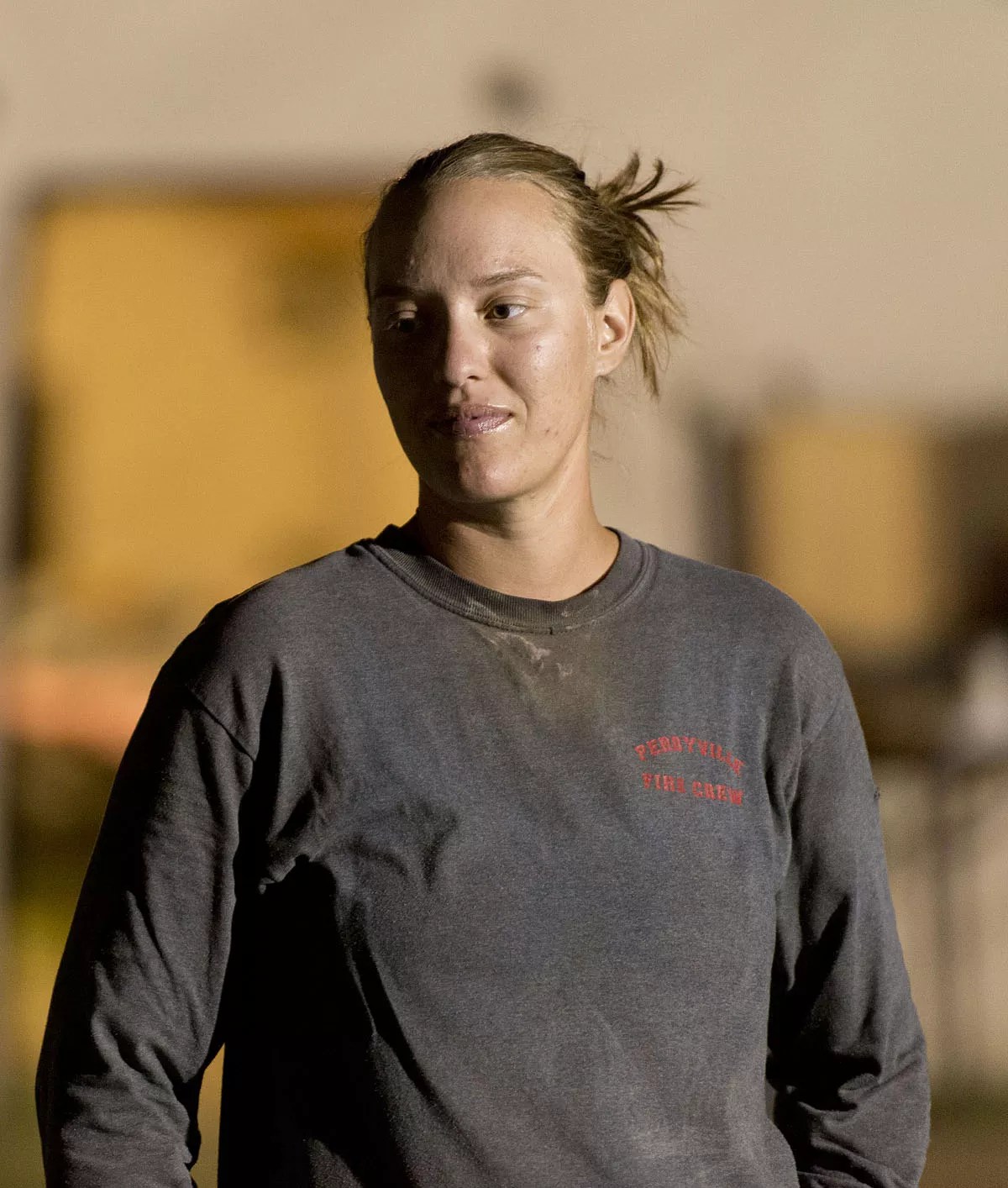
Sarah Schneck
Pablo Robles
“I saw the change in her. I saw the respect,” Schneck says.
Krista Countryman went to prison for a third stint in 2015, also on drug charges.
“I had to grow up. I have a daughter I haven’t seen for a long time because I chose to live my life as a child,” she says.
In prison, trust is a rare and valuable commodity. Countryman found it, and more.
“All the friends I should have been making all my life, I’ve made here,” Countryman says. “The teamwork is something I’ve never experienced before.”
“It was hard going from an addict, knowing your life is worthless,” she adds. “I feel good about myself for the first time.”
Regina Brandt was busted on a burglary rap in 2014. It landed her in prison for the third time, too.
She remembers the day on the yard when her life changed.
“I’m looking off in the distance I see this line of 20 amazing women, walking with pride and purpose, all in uniform,” Brandt says. She thought about her life slipping away from her, without meaning. When she saw that fire crew, she says she thought, “I’m older. I’m feeling I’m running out of time.”
Once she joined, the broken pieces of her life started to fit somehow. The assignment came with a promise: “If you can do this, if you, too, work to do this, we’ll fix you.”
It wasn’t handed to them.
They had to keep an impeccable prison discipline record. Then, they had to pass all the same tests regular wildland firefighters take. That meant heaving a 45-pound pack for three miles in under 45 minutes. Their times are posted, and they surpass those of many professional male firefighters.
To other firefighters, there is no difference. Nobody cares about the women’s pasts. They care that the women get the job done. They do.
“To any firefighter looking at the yellow shirt, they are all firefighters,” says Sergeant Dan Carpenter, the prison officer who supervises them.

The 20 members of the Perryville women
Courtesy of Arizona Department of Forestry and Fire Management
FREEDOM FOR PRISONERS, CAPTORS
Cynics like to think prison work crews are an easy gig. They are outside, not confined. It’s a ploy for better treatment and early release. These are criminals. They don’t really mean it, the cynics say.
On the fire lines, the work is hard, dirty, hot, and relentless. Each shift is 12 hours of grinding manual labor, and each firefighter consumes 6,000 calories of food to accomplish it.
But the Perryville women are not just freeing themselves. They are freeing their captors.
Dan Carpenter has been a prison guard for the Arizona Department of Corrections for 13 years. He’s housed, watched, and disciplined some of Arizona’s toughest offenders. He took over the women’s fire crew in January and had no idea what he’d find.
“It was an eye-opener,” Carpenter says. He was used to what he called the “higher customer” units, where he would watch the hardcore criminals on release day and pick out the ones who were coming back.
ADOC says about 28 percent of female offenders return within three years. The agency doesn’t track recidivism among the fire crews, but says they are “among the very lowest likely to recidivate,” and do so at “significantly lower rates” than the general population.
Carpenter saw the difference between the rehab and punishment sides of the job.
“I came to this side of the house, and this is all about change. People have to want to change,” he says. “On this side, they put in the effort, every day. They give me 100 percent.”
That brings its own rewards.
“This instills discipline, respect for others. They help others,” he says, needing to be reminded that he is talking about criminals. “The last fire, they did structure protection. People thanked them. This was something meaningful to them.”
And then Carpenter noticed something unexpected. The prisoners had changed him.
“In DOC, it’s my way or that’s it. There’s no input from the inmate. Up here, input from the inmates, it’s vital,” he says, particularly because the women know fire better.
In the cellblocks, he’d become jaded.
“My management of people has changed. I was very black-and-white, by the book. But there’s a different way to manage people,” he says.
The system is watching, too. These women who society threw away and forgot are not forgotten now.
“They do phenomenal work on behalf of the public and the state,” ADOC spokesman Andrew Wilder says. “It does fit with Governor (Doug) Ducey’s drive toward reducing recidivism, which is a drive we share.”
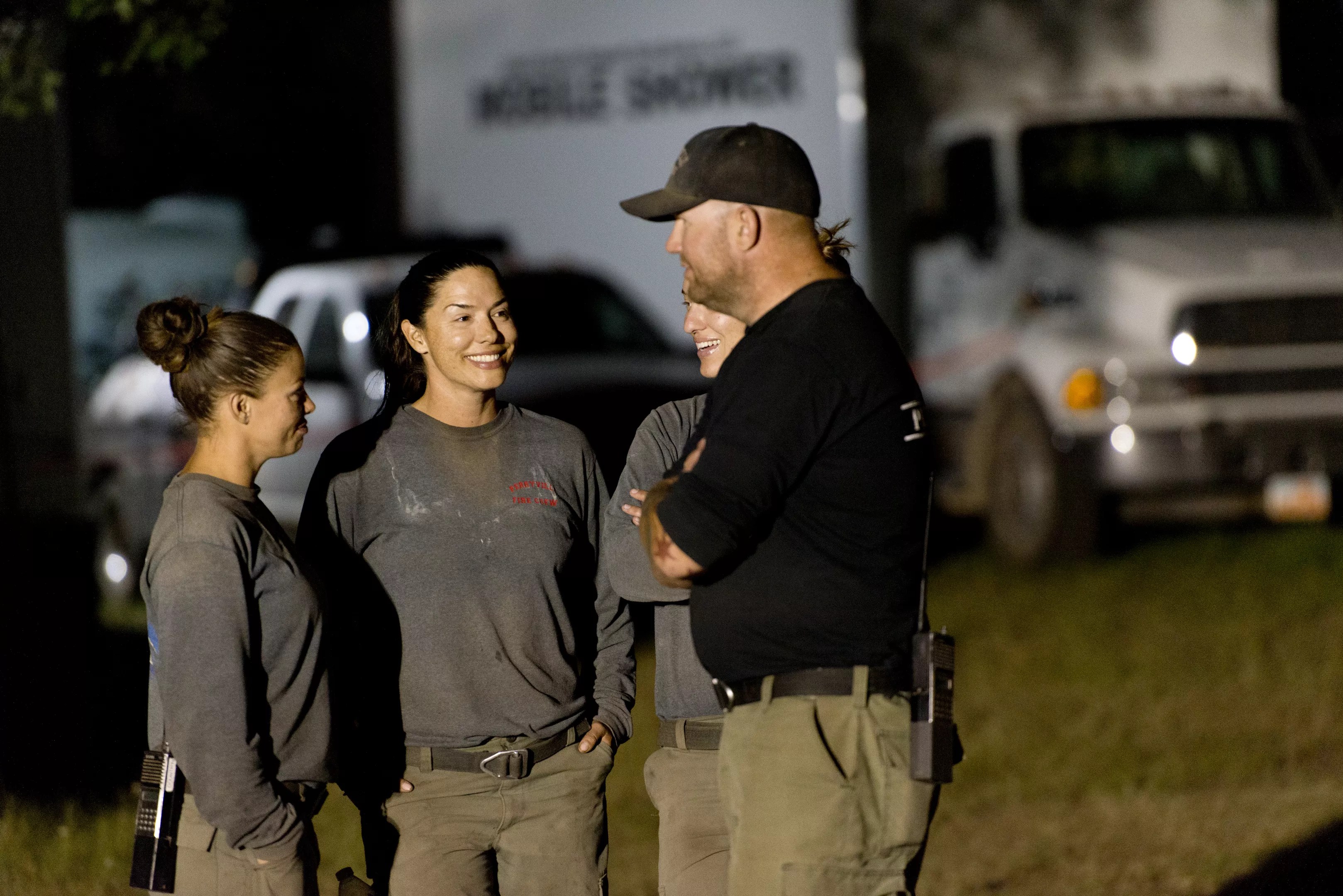
From left, Krista Countryman, Regina Brandt, and Sarah Schneck with ADOC’s Dan Carpenter.
Pablo Robles
FINALLY TAMING THE BRAT
This day, the fire is 76 percent contained, commanders report at the morning briefing. The 6,768-acre blaze is now mostly smoldering in the trees north of the Rim. Already, commanders are scaling back the operation, starting to send some of the firefighters home or to other, higher priority fires.
The Perryville women are up on the Rim, grinding up brush that had been cleared to create fuel breaks along Fire Road 139. They are putting the forest back to how it’s supposed to be.
By dinnertime, the fire is 92 percent contained, and 916 firefighters remain. The operation had gone smoothly, perfectly to plan, and the fire had only grown by 171 acres.
Below the Rim, a scattering of isolated communities dots the landscape inside the national forest, accessible only by dirt road. It was here the Highline and Dude fires both broke out. It was here that the only evacuation in this year’s fire was ordered. And it was here the brat was tamed.
On a bare hill above the settlements of La Cienega and Ellison Creek estates, you can see exactly where. Along the Rim lies a charred, charcoal-color ridge to the west. In the middle is a salmon-colored ridge. To its east, the next ridge is green.
It’s like Neapolitan ice cream, with each flavor carrying special meaning: black for burned, green for growing, and red for retardant.
As flames advanced along the face of the cliffs, this exact spot is where large tankers stopped it by coating the slopes with red slurry. Hand and machine crews did the rest, and it was touch-and-go.
One of those crews had come in from Utah, and this day they are getting a chance to rest under some oak trees, where the road ends and bucolic meadow opens up next to a mansion and helipad owned by Arizona State University.
Among them is Adam Stoldal, who sports a long, bushy beard and intelligent dark eyes behind a pair of thick glasses that look like old-fashioned car-racing goggles.
“The conversation was always: right ridge, right time. And they got it,” the Cedar City, Utah, man says.
Before that, 108 homes, mostly summer cabins for Valley folks, were threatened. Ten people left. Had the plan failed, the flames would have started flanking the crews on the lower slopes and edged toward homes on two sides, aided by a bad combination of wind, topography, and fuel. It didn’t.
Stoldal and his crew, which was assembled from forests, parks, and other federal lands in southern Utah, had pushed 300 feet beyond the fire’s burned-out perimeter to put out hot spots. This was their 19th consecutive day working fires.
The field, once filled with buggies, ATVs, and fire rigs, is now empty. The skies, once filled with planes and helicopters, are silent. Up the road, a temporary water tank and a giant rubber bladder are the only remnants of the air operation.
Wisps of smoke drifted on the stiff afternoon breeze above, up where the Perryville women are. That unmistakable scent of fire wafts on the breeze. It is another reminder of the dangers of fighting fire in that place, and that even now, nobody could really relax.
It takes 10 hours to reach the Perryville team, because in the early afternoon, the skies darken, thunder grumbles, and stiff wind rush through the small pinon pines on the edge of the cliffs.
The radio crackles, ordering everyone back from the cliffs to predetermined safety zones. Sit tight there, the radio says. This was lightning weather, the kind of weather that blows embers around, the kind of weather that sparks lightning strikes. The kind of weather that starts spot fires and traps firefighters.
The brat still has some fight in him, and earlier in the day than usual, he was conspiring with the Sky Spirits.
This isn’t so different from the weather in Yarnell that day so many died.
But this time, the plan works, the fire subsides, and, even though there are 20 cases of heat-related illness, everybody gets out safely.
THEY DON’T WANT TO RETURN TO PRISON
Getting out, and staying out. That’s what you think about when you are in Perryville. It’s what the women were thinking about up on the Rim. No one expects to see them back behind bars, once they close behind them.

Regina Brandt
Pablo Robles
All three women will get out of Perryville sometime next year. All three want to go into a firefighting career. All three say they have no plans on going back behind the confines of razor wire and lockdowns.
“Fire made me who I am. It shows you how strong you are. It brings light to your life,” Schneck says.
“We do it for the challenge. It’s an amazing thing,” Countryman says. She wants to become a hotshot, considered the elite among those who fight wildfires, like one male inmate before her.
Brandt has an extra motive. Before her dad, Dale Brandt, died of brain cancer, he was named Phoenix’s firefighter of the year. “This is the way I can fulfill my dad’s legacy.”
She feels his presence among the trees and dark and smoke of Spike Camp 139.
“He’d say, ‘Don’t quit.’”